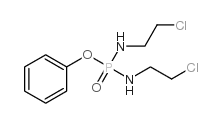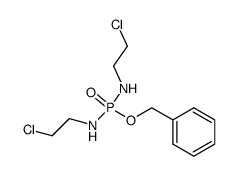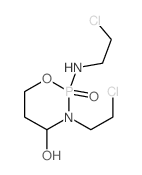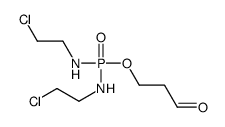31645-39-3
| Name | Palifosfamide |
|---|---|
| Synonyms |
Phosphorodiamidic acid, N,N'-bis(2-chloroethyl)-
Isophosphamide mustard Ipam Ifosforamide mustard N,N'-Bis(2-chloroethyl)phosphorodiamidic acid ifosfamide mustard isophosphoramide mustard isophosphoramide isophpsphoramide mustard Palifosfamide |
| Description | Palifosfamide is a novel DNA alkylator and the active metabolite of ifosfamide, with antitumor activity. |
|---|---|
| Related Catalog | |
| In Vitro | Palifosfamide lysine (ZIO-201) is a stable form of palifosfamide. Palifosfamide lysine has broad activity in sarcoma lines in vitro. The IC50 ranges from 2.25 ro 6.75 μM for most cell lines except OS222 (IC50=31.5 μM)[1]. |
| In Vivo | Tumor growth inhibition is seen in both OS31 and OS33 xenografts and the RMS xenograft resulting in a significant difference in event-free survival between the control and the treated groups. Differential gene expression of ALDH3A1 but not ALDH1A1 is noted in the OS31 xenograft[1]. Stabilized palifosfamide administered to mice suppresses MX-1 tumor growth by greater than 80% with 17% complete antitumor responses. Oral bioavailability in rats is 48-73% of parenteral administration, and antitumor activity in mice is equivalent by both routes. Treatment with palifosfamide-tris combined with docetaxelor doxorubicin at optimal regimens results in complete tumor regression in 62-75% of mice[2]. |
| Cell Assay | Palifosfamide is dissolved in phosphate buffered saline (PBS). Cells are plated in 96-well microtiter plates with approximately 500 cells per well in 100 μL of media. After 24 h of incubation at 37°C, cells are treated with increasing concentrations of palifosfamide lysine in separate plates either as a single-day treatment or three consecutive days of treatment, with fresh drug being added each day. The plates are incubated for 72 h at 37°C with 5% CO2. After 72 h, 250 μg of MTT is added to each well and incubated at 37°C for 6 h. MTT is converted to formazine crystals by mitochondria of viable cells, which are then dissolved in 100 μL of dimethyl sulfoxide. Optical density is measured at 595 nm[2]. |
| Animal Admin | Mice: CB17 female SCID mice are used in the study. Once the tumors reached 50–150 mm3, mice are randomized into control and treatment groups (5-8 mice/group) for each tumor line. Cyclophosphamide is administered at the dose of 150 mg/kg intraperitoneally once a week for 6 weeks. Palifosfamide lysine is administered intravenously at the maximum tolerated dose of 100 mg/kg for three consecutive days as a one-time treatment and serial tumor volumes are determined over the next 6 weeks. Mice are sacrificed at the end of the experiment[2]. |
| References |
| Density | 1.4±0.1 g/cm3 |
|---|---|
| Boiling Point | 341.5±52.0 °C at 760 mmHg |
| Melting Point | 106-107ºC |
| Molecular Formula | C4H11Cl2N2O2P |
| Molecular Weight | 221.022 |
| Flash Point | 160.4±30.7 °C |
| Exact Mass | 219.993515 |
| PSA | 71.17000 |
| LogP | -1.05 |
| Appearance | white solid |
| Vapour Pressure | 0.0±1.6 mmHg at 25°C |
| Index of Refraction | 1.498 |
| Storage condition | -20℃ |
|
~68% 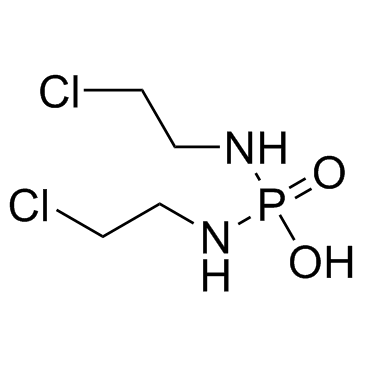
31645-39-3 |
| Literature: Lorenz; Wiessler Archiv der Pharmazie, 1985 , vol. 318, # 7 p. 577 - 582 |
|
~46% 
31645-39-3 |
| Literature: Duan, Jian-Xin; Jiao, Hailong; Kaizerman, Jacob; Stanton, Timothy; Evans, James W.; Lan, Leslie; Lorente, Gustavo; Banica, Monica; Jung, Don; Wang, Jinwei; Ma, Huaiyu; Li, Xiaoming; Yang, Zhijian; Hoffman, Robert M.; Ammons, W. Steve; Hart, Charles P.; Matteucci, Mark Journal of Medicinal Chemistry, 2008 , vol. 51, # 8 p. 2412 - 2420 |
|
~83% 
31645-39-3 |
| Literature: Misiura; Okruszek; Pankiewicz; Stec; Czownicki; Utracka Journal of Medicinal Chemistry, 1983 , vol. 26, # 5 p. 674 - 679 |
|
~% 
31645-39-3 |
| Literature: Chemical Research in Toxicology, , vol. 8, # 7 p. 979 - 986 |
|
~% 
31645-39-3 |
| Literature: Journal of Medicinal Chemistry, , vol. 32, # 8 p. 1768 - 1773 |
